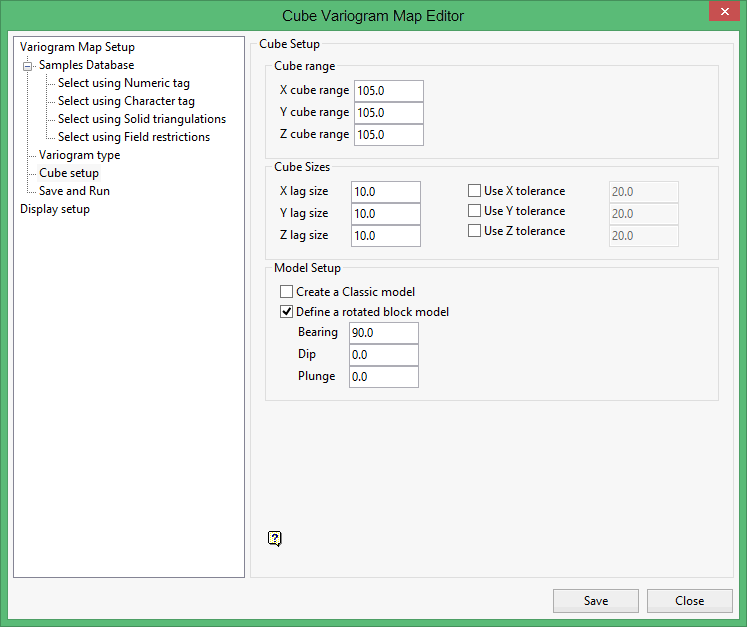Cube Setup

X/Y/Z cube range
For each dimension, enter the range of the variogram model. A range of 105 means that the block model extends from 105 to 105.
X/Y/Z lag size
For each dimension, enter the size of the cube. The size is usually in the order of the distance between samples. Making the size large puts more sample pairs into each block, but reduces the resolution.
Lag tolerance
Enter the distance in which to use the samples. When this is set to 0, a sample pair is put in the closes lag. If this is a positive number, then the sample pair must be in this distance of the lag centre. A lag tolerance greater than half the lag size will imply that some samples will be used in two lags. This can be useful to get smoother results.
For example: If the lag size is 10, and two samples are a distance of 23 from each other, then their correlation information is usually stored in the lag at a distance of 20. However, if the lag tolerance was set to 2, then this pair would be ignored since 23 is further than 2 away from 20. Normally this parameter is set to 0.
Model Setup
|
Format Comparison |
|||
|
Classic |
Extended |
Compressed Extended |
|
| Data allocation | All data must be allocated when the block model is constructed. | No data is stored when a block model is created. Disk space is dynamically allocated when values are stored into blocks. |
Same as Extended. |
| Block model blocks | Restricted to 2x109blocks. | Can exceed 1018blocks |
Same as Extended. |
| Indexing | You require an amount of free disk space that is equal to the size of the actual block model. For example, if the block model is 4Mb in size, then you will need to have a minimum of 4Mb free disk space in order to perform the index procedure. |
No extra disk space is required in order to perform the index procedure. In a regular extended model the index is not stored, but is implied, so the model is always indexed. In a sub-blocked extended model the index is stored in such a way that it does not need to be rewritten, so the model remains indexed. |
Same as Extended. |
| Miscellaneous | Models can be created very quickly. Model may contain a large number of blocks, well in excess of 4 billion blocks. Variables may be added and removed quickly. Disk space is only used for block values which are stored. |
This format works best with block models that have a lot of categorical variables, as opposed to variables that are estimated. |
Related topics

